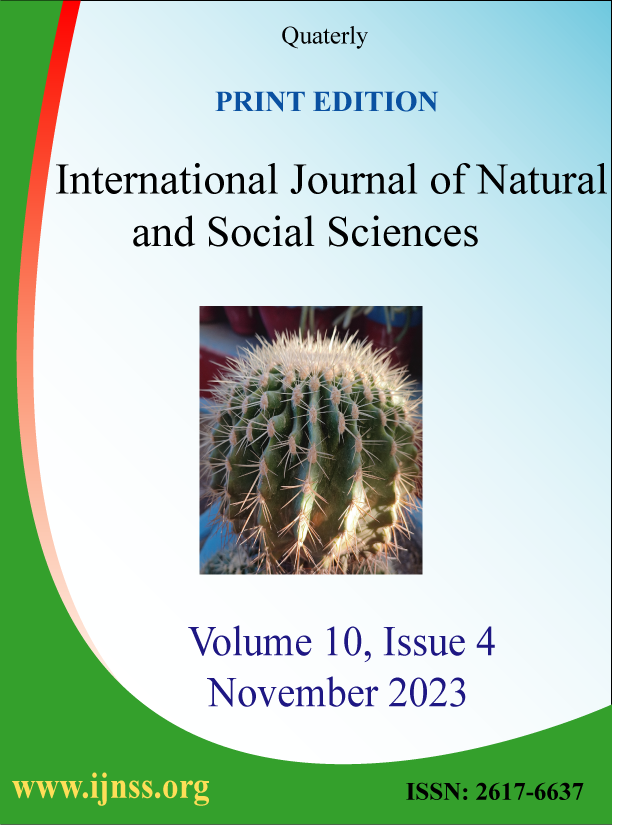Prevalence of Balantidium coli infection in man in Mymensingh, Bangladesh
Md. Abdullah-Al-Hasan1![]()
![]() , Md. Ashraf Ali2, Md. Abdullah-Al-Hasan3, ATM Faiz Khan Rakib4, Mohammad Ashraful Alam5, MM Hussain Mondal1
, Md. Ashraf Ali2, Md. Abdullah-Al-Hasan3, ATM Faiz Khan Rakib4, Mohammad Ashraful Alam5, MM Hussain Mondal1
1Deaprtment of Parasitology, Bangladesh Agricultural University, Mymensingh-2202, Bangladesh
2Deaprtment of Pathology and Parasitology, Jhenidah Government Veterinary College, Jhenidah, Bangladesh
3Departmen of Microbiology and Hygiene, Sylhet Agricultural University, Sylhet, Bangladesh
4Departmen of Pharmacology, Bangladesh Agricultural University, Mymensingh-2202, Bangladesh
5Departmen of Microbiology and Hygiene, Bangladesh Agricultural University, Mymensingh-2202, Bangladesh
| ABSTRACT | Get Full Text PDF |
An epidemiological survey of Balantidium coli infection (balantidiasis) in man was studied during July to November, 2010. A total of 150 samples were examined through Stoll’s ova counting technique of which 6.67 % were found to be infected with B. coli. In this study, prevalence of balantidiasis in relation to age, sex, socio-economic status and month of the year was also studied. Prevalence of B. coli was significantly higher in adult aged >6 years (10.77%) than in young aged < 6 years (3.53%). Higher prevalence was observed in male than that of female. Relatively higher prevalence of B. coli was observed in July and September months. Prevalence of B. coli was significantly (p<0.05) higher in lower class than middle class people. The cysts of B. coli per gram of stool were 100-600 with a mean value of 232.0±12.18 cysts per gram stool. The occurrence of B. coli infection in man indicating a significant health threat of this zoonotic parasite in Bangladesh. Further extensive research is needed to understand the transmission dynamics of this parasite for taking necessary steps in controlling balatidiasis in Bangladesh.
Key words: Prevalence, Balantidium coli, man, Bangladesh.
![]() Corresponding author. Tel.: +8801717998874
Corresponding author. Tel.: +8801717998874
E-mail address: hasanvet30@gmail.com (AA Hasan)
How to cite this article: MAA Hasan, MA Ali, MAA Hasan, AFK Rakib, MA Alam and MMH Mondal (2015). Prevalence of Balantidium coli infection in man in Mymensingh, Bangladesh. International Journal of Natural and Social Sciences, 2(1): 33-36.
INTRODUCTION
Balantidium is the only ciliated protozoan known to infect humans and is the largest protozoan infecting humans and non human primates. B. coli have two developmental stages, a trophozoite stage and a cyst stage and usually affect the large intestine, from the caecum to the rectum. The trophozoite is motile having two nuclei (macro and micronucleus) and contains cilia around its ovoid shaped body, naturally voided with faeces of the affected individuals and contaminates food and water (Samad, 1996). Cysts are round shaped, smaller than trophozoites and have a tough, heavy cyst wall made of one or two layers and formed during the adverse climatic condition. Infection occurs when the cysts are ingested with contaminated food or water and pass through the digestive system of the host where excystment (in large intestine) takes place to produce trophozoites. B. coli fundamentally affect the colon and causes clinical manifestation from asymptomatic to serious dysenteric forms (Lazar et al., 2004). B. coli also produces hyaluronidase (Tempels and Lipenko, 1957) which potentially enhancing its ability to invade the intestinal mucosa causing enteritis.
Balantidiasis is a zoonotic disease and is acquired by humans via the fecal-oral route from the normal host, the pig, where it is asymptomatic. Water is the vehicle for most cases of balantidiasis. Human-to-human transmission may also occur. B. coli habitats in humans remain in cecum and colon. Humans may remain asymptomatic, as does the pig, or may develop dysentery similar to that caused by Entamoeba histolytica. Total dysentery caused by B. coli in male patient a fatal case is reported from Costa Rica (Hernandez et al., 1993). B. coli may also cause acute cecal appendicitis in man (Onzalez, 1978). Another fatal of B. coli case is also reported in a woman suffering from anal cancer (Vasilakopolou et al., 2003). Pneumonia has also been reported in patients with chronic lymphocytic leukemia (cancer) related immunosuppression and has not always been associated with direct contact of pigs (Anargyrou et al., 2003). Death is an infrequent consequence of balantidiosis, but in developing countries with under nourished and over parasitized populations; it can make the difference between a healthy life and chronic debilitation.
The geo-climatic condition of Bangladesh is favourable for the development and survival of various parasites including B. coli (Datta et al., 2004). In India, Kaur et al. (2002) reported 2.4% prevalence of B. coli in children. In many developed countries, the data on the prevalence of B. coli were published in an efficient manner as an aid to combat balantidiasis more efficiently. Several reports on the epidemiological surveys of protozoan parasites in animals and humans are available in Bangladesh but only a few reports of balantidiasis in man have been published. A detailed study of the disease pattern is necessary. Therefore, the present study was undertaken with the aim to study the prevalence of B. coli infection of man in relation to age, sex and socio- economic condition and months of the year in man in Bangladesh.
MATERIALS AND METHODS
Study area
Fecal samples of man were collected from different sites of Mymensingh Sadar, Muktagachha and workers of Bangladesh Agricultural University Dairy Farm (BAUDF). Morphological examination was done in the Department of Parasitology, Bangladesh Agricultural University, Mymensingh, Bangladesh. The research activities were carried out for a period of five months, from July to November, 2010.
Selection of sample
One hundred and fifty (150) stool samples (one sample from one man) were collected randomly irrespective of age, sex, health, socio-economic status and months of the year from the study areas. Most of the man live in the rural areas and reared livestock in their house. The age and sanitary condition was determined from interrogating the farmers.
Collection and examination of stool samples
Plastic bottles were supplied to the selected farmers who kept their stool in the supplied bottles. In the next morning, the stool containing bottles were collected and labeled properly. Then the samples were brought to the laboratory in presence of 10% and examined as early as possible. The stool samples were examined by Stoll’s Ova counting technique for counting the number of cysts or trophozoites per gram of stool. The cyst and trophozoite were identified by their characteristic morphological features as described by Soulsby (1982).
Statistical analysis
F test was performed to compare two variables in this study by using the Statistical Package for Social Sciences (SPSS) program. Odds ratio were calculated according to the formula given by Schlesseman (1982).
RESULTS
Prevalence of B. coli infection in man
The prevalence of B. coli was 6.67%. The total cyst per gram of faeces was 100-500 with an average count 232.0±12.18. The result is in accordance with the study of Bouree et al. (1984) who found 6% prevalence of balantidiasis in man. The findings in the present study is much higher than the earlier reports of Pampiglione et al. (1987) and Adekunle et al. (2002) who recorded 0.1% and 0.8% prevalence of balantidiasis in Itali and Nigeria; respectively. The variations between the present and previous findings might be due to difference in geographical locations, period of study, climatic condition of the research area, and nutritional factors of the man.
Age related prevalence of B. coli infection
The age specific prevalence of B. coli infection was presented in the table 1. The prevalence of B. coli was higher (10.77%) in aged >6 years than aged <6 years (3.53%). The calculated odds ratio reveals that man > 6 years were 3.33 times more likely to be infected by B. coli than that of < 6 years. It is observed that the age of the man had significant effect (p<0.01) on the prevalence of B. coli infection. Man aged > 6 years are more susceptible (10.77%) to balantidiasis than young aged < 6 years (3.53%). This report is supported to the earlier findings of Biu et al. (2008) who reported the prevalence of balatidiasis more in human aged > 6 years (12.3%) than aged ≤ 6 years (3.4%). It is assumed that man aged > 6 years gets more exposure in environment, so as they take more contaminated food and water as a source of infection. On the other hand, man aged ≤ 6 years had little opportunity to get contaminated food and water as they are mostly depend upon the mother milk.
Sex related prevalence of B. coli infection
Prevalence of B. coli was higher in male (10.00 %) than female (2.86%) and males were 3.77 times more likely to be susceptible to balantidiasis than that of female (Table 1). The present finding was supported by Biu et al. (2008) who reported that prevalence of balantidiasis was higher in male (11.5%) than female (3.4%).
Table 1
Age related prevalence of balantidiasis in man
| Factors | Age | No. of positive cases | Cyst per gm for stool | Odds ratio | ||
| No. | Prevalence (%) | Range | mean±SD | |||
| Age | <6 years(n=85) | 3 | 3.53 | 100-500 | 300.0±26.5 | >6 years Vs <6 years = 3.33 |
| >6 years(n=65) | 7 | 10.77 | 200-200 | 250.0±19.1 | ||
| Sex | Female (n=70) | 2 | 2.86 | 100-500 | 400.0±30.0 | Male Vs female = 3.77 |
| Male (n=80) | 8 | 10.00 | 100-200 | 250.0±14.3 | ||
| Class | Medium (n=52) | 2 | 3.85 | 100-400 | 300.0±24.2 | Low Vs Medium = 2.22 |
| Lower (n=98) | 8 | 8.16 | 100-500 | 393.0±22.2 | ||
| Total | 150 | 10 | 6.67 | 100-600 | 125.0±4.50 | |
| P-value | 0.0256* | |||||
1 n= Total number of samples examined
** Indicates significant (p<0.01)
Table 2
Monthly prevalence of balantidiasis in man
| Months (n) | No. of positive cases | Cyst per gm for stool | ||
| No. | Prevalence (%) | Range | mean±SD | |
| July (45) | 5 | 11.11 | 100-500 | 300.0±26.5 |
| August (58) | 3 | 5.17 | 100-200 | 220.0±16.4 |
| September (9) | 1 | 11.11 | 100-600 | 240.0±20.7 |
| October (28) | 1 | 3.57 | 100-100 | 250.0±19.1 |
| November (10) | 0 | 0.00 | 0.00 | 0.00 |
| P-value | 0.0025** | |||
1 n= Total number of samples examined.
** Indicates significant (p<0.01)
Month related prevalence of B. coli infection
The prevalence of B. coli in man was significantly higher during the July and September (11.11%) followed by August (5.17%), October (3.57%) No infection was observed in November (Table 2). This finding is supported to the report of Biu et al. (2008) who observed the higher prevalence of B. coli in man during July (10.8%), followed by August (6.10. %) and September (10.5%) in Nigeria. The present finding is differed from the finding of Ogunba (1977) who reported higher prevalence of balantidiasis in November This difference might be due to difference in geographical location with different settings of environment and hygiene
Effect of socio-economic status on prevalence of B. coli infection
The prevalence of B. coli infection in relation to socio-economic status was presented in the Table 1. It was observed that the prevalence of B. coli was significantly (P<0.05) higher in lower class man (8.16%) than medium class man (3.85%). The calculated odds ratio revealed that lower class man was 2.22 times more likely to be infected by B. coli than middle class man. This finding is supported to the report of Adekunle et al. (2003) who observed the higher prevalence of balantidiasis in lower class (37.1%) than medium (33.4%) class man. Lapage (1962) found that malnourished animals are more susceptible to any infection as they are immunocompromised. However the higher prevalence of B. coli in lower class people is probably due to the poor dietary habit, poor sanitary condition, drinking of contaminated water and lack of knowledge about health and hygiene.
Balantidiasis is a zoonotic disease, it is necessary to study the transmission dynamics of the parasite in Bangladesh in order to control the disease.
REFERENCES
Adekunle and Lola (2002). Intestinal parasites and nutrinational status of Nigerian children. African journal of Bio-Medicine, 5(1): 115-119.
Anargyrou K, Petrikkos GL, Suller MTE and Skiada A (2003). Pulmonary Balantidium coli infection in a leukemic patient. American Journal of Hematology, 73(3): 180-183.
Biu AA and Dauda M (2008). Prevalence study on enteric protozoans responsible for a copromicroscopical investigation in Sardinia. Parassitologia, 48 (14): 313-314.
Datta S, Chowdhury MK, Siddiqui MAR and Karim MJ (2004). A retrospective study on the prevalence of parasitic infection in ruminants in selected areas of Bangladesh. Bangladesh Veterinary Journal, 38:25-33.
Hernandez F, Arguello AP, Rivera P and Jimenez E (1993). Balantidium coli (Vestibuliferida: Balantidiidae) the persistence of an old problem. Revista de Biologia Tropical, 41(1) 149-151.
Kaur R, Rawat D, Kakkar M, Uppal B and SharmaVK (2002). Intestinal parasites in children with diarrhea in Delhi,India. Southeast Asian journal of tropical medicine and public health, 33(4):725-729.
Lapage G (1962). Monig’s Veterinary Helminthology and Entomology, 5th edition. Bailiere, Tindall and Cox Ltd. London, UK. pp: 556-723.
Lazar S, Altuntas F, Sahin I and Atambay M (2004). Dysentery caused by Balantidium coli in a patient with non Hodgkin’s lymphoma from Turkey. World Journal of Gastroenterology, 10(3): 458-459.
Ogunba EO (1977). The prevalence of human intestinal protozoa in Ibadan, Nigeria. Journal of Tropical Medicine and Hygiene, 80(9):187-191.
Onzalez SO (1978). Acute appendicitis caused by Balantidium coli. Revista cubana de medicina tropical, 30(1): 9-13.
Samad MA (1996). Examination procedure of animals. Pashu Palon O Chikitsavidya (Animal Husbandry and Medicine). Lyric-Epic Prokasoni, Mymensingh, pp; 127-133.
Schlesseman G.V (1946) Case-control studies. 1st edition, Oxford University press, New York, pp. 174-177.
Soulsby EJL (1982). Helminths, Arthropod and Protozoa of Domesticated Animals. 7th edition, Bailliere Tindal and Cassell Ltd., London, pp. 757-759.
Temples CH and Lipenko MG (1957). The production of Hyaluronidase by Balantidium coli. Experimental parasite, 6:31-36.
Vasilakopolou A, Dimarongona K, Samakovli A, Papadimitris K and Avlami A (2003). Balantidium coli pneumonia in an immunocompromised patient. Scandinavian Journal of Infectious Diseases, 35(2):144-146.






